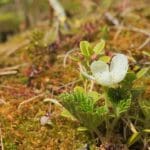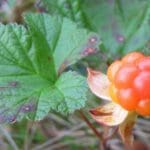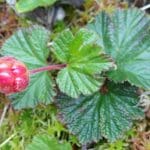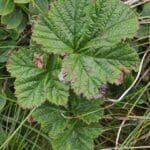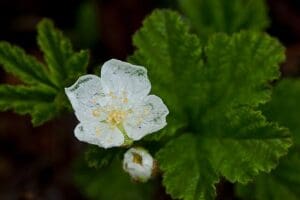Cloudberry/ Spring / Summer / Autumn / Edible
An interesting perennial relative of Blackberries and Raspberries, with striking orange fruits. It is native across cooler temperate to boreal regions of the world. In the UK they are mainly found in higher altitudes. The English name makes sense when you notice that they tend to grow in high places with a lot of mist and clouds!
Common Names
knotberry, knoutberry, oot berry, lambs leaf
Botanical Name
Rubus chamaemorus
Scientific Classification
Kingdom – Plantae
Order –Rosales
Family – Rosaceae
Physical Characteristics for Cloudberry
Leaves
The plant looks similar to a common blackberry, but is overall a bit smaller and less vigorous. The sprawling stems and covered with small prickles. Thedeeply veined leaves are matte green, sometimes tinged with bronze, and have 5-7 wide lobes.

Flowers
The flowers appear from May onwards, and have five white to cream petals, with a cluster of yellow to brown anthers in the middle and five bracts on the back. They resemble a small wild rose
Fruit/Seeds
The fruits ripen in July, turning from red to an eye catching golden orange. They look like a small orange blackberry, being made up of a cluster of bobbles or ‘drupelets’. The drupes are smaller than a blackberry but with individual drupelets that are a bit bigger. There is a small seed inside each individual bobble of the fruit.
Roots
Cloudberry can form extensive spreading rhizomes, up to 10 metres long
Habitat
Cloudberries prefer acidic soils in colder regions and higher altitudes. It can be found in bogs, marshes and moorland. In the UK it is relatively rare, being found in more mountainous areas of Northern England, North Wales and Scotland.
Known Hazards
None known, apart from minor scratches from the prickly stems
Could be Confused with
It would be very easy to confuse Cloudberry with other Rubus species, most often the Blackberry (Rubus Fruticosus) which is much more common and has black blue/black berries. However this would not be a deadly mistake as the other Rubus species are generally also edible.
Edible Uses
The fruits can be eaten just like a blackberry, but taste more tart even when fully ripe . They are prized in a variety of traditional desserts and liqueurs in Nordic countries, Alaska and Canada. They can be used raw, scattered fresh on desserts, porridge or muesli, incorporated into pies and crumbles or made into jam. The leaves can be used as a herbal tea
Notes on Herbal Uses
The fruits are high in antioxidants and polyphenols – and the high Vitamin C content meant they were used to ward off scurvy through the long Northern winters and by seafarers on long voyages. It seems to also have some interesting antibacterial properties . Some modern skincare brands are including cloudberries in their products for the antioxidant and anti-inflammatory properties. The leaves can be used as a tea.
Conservation Considerations
The Cloudberry has suffered from habitat loss and is considered rare and endangered in Ireland and Germany, for instance. The habitats you might find it in can potentially be quite rare and sensitive – you should try not to cause too much disturbance while exploring. Do not go picking on SSSIs , just appreciate the unique ecology and do your bit to preserve it.
Extra notes from the Foragers
The genus Rubus is pretty confusing even for experienced botanists, with lots of hybrids and micro-species. So don’t beat yourself up if you find them tricky at first!



